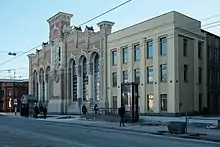VEF
VEF, Latvian acronym for Valsts elektrotehniskā fabrika (State Electrotechnical Factory), was a manufacturer of electrical and electronic products in Riga, Latvia. It was founded in 1919. Before World War II, it manufactured a large variety of goods, including Minox — then the world's smallest camera. After the war, it was the leading communication technology producer in the Soviet Union and the largest factory in the Latvian SSR.[2]
 | |
 Street view of VEF oldest buildings in 2017. Architect Heinrich Scheel | |
| Type | Public |
|---|---|
| Industry | Electronics, telecommunications, radio receivers, photography, aircraft |
| Founded | 1919 |
| Defunct | 1999 |
| Headquarters | Riga, Latvia |
Area served | Interwar Latvia (1918-1940), Soviet Union (1940-1991), Latvia (1991-1999) |
| Products | Minox, VEF Spidola, VEF I-11, etc |
Number of employees | 4000 (1938)[1] |
History
VEF was established in April 1919 as The Main Workshops of the Latvian Post and Telegraph Department (Latvian: Pasta un telegrāfa virsvaldes galvenā darbnīca (PTVGD)), where, initially, the five mechanics were the only employees.[3] In 1924 the factory was moved for the first time, and in 1928 moved again to its VEF's current location. The factory buildings were built in late 19th and early 20th century and span a city block. Before World War I the buildings were owned by 1887-established Russian-Baltic factory UNION, established by Heinrich Dettmann.[2][4][5] The company was renamed to VEF in 1932.[6]

In 1922 PTVGD started to manufacture phones. In 1924 it started producing crystal-detector radios.[2] In 1928 it began producing automatic telephone exchanges. They bought the license from Mix & Genest to produce small volume (for 100, 200, 300 numbers) and large volume (1000, 2000 numbers) switchboards. Telephone exchange in Riga and Latvia's populated places were upgraded with equipment manufactured by PTVGD until 1940.[6] During the 1930s the monthly production of PTVGD included 500 phones and 400 exchanges.[2] By the 1930s the factory produced all electronics that had any market demand - communication devices, phones, light bulbs, cameras, irons, radios, flashlights, as well as photo paper, work-tables, and even airplanes.[2][7] They also repaired cars.
VEF entered the world market in 1936 with the development of the Minox subminiature camera, designed by Walter Zapp (Latvian: Valters Caps). It was the world's smallest camera at the time.[2]
Between 1928 and 1933 VEF also produced a small, inexpensive car.
During World War II the factory was looted and several buildings were destroyed by explosions. The factory was repaired after the war and it quickly recovered. During the 1960s VEF produced seven radio receivers and five phones every minute and two out of three phones in Soviet Union were produced by VEF. It also manufactured highly demanded transistor-based radios "Spīdola" and in the 1970s — "VEF".[2]
During the Soviet period, VEF specialized in electronics and was a part of Latvia's electronic industry, which supplied the former Soviet Union with telecommunications equipment and electronics for the military. The five largest state companies were VEF, Radiotehnika, Elfa, Komutators and Elar (which produced components for the other four). In its peak in 1991, VEF employed 20,000 people. Its best known products were telephones, telephone exchanges and radios.

The Latvian electronics industry had trouble competing with Western companies when the markets were opened in the early 1990s. Cited problems included poor service and product quality. Attempts to restructure these companies were not successful and their combined production fell more than 90% between 1993 and 1997. VEF was divided into six smaller companies, most of which no longer exist. Three remaining ones, VEF un Ko, VEF TELEKOM and VEF Radiotehnika RRR, employ between 100 and 200 people each.

In 1999 the factory was privatized and reorganized.[2]
Building
Originally built in 1899. The large assembly hall and administrative building, designed by architect Heinrich Scheel (1829–1909), have eclectic facades facing Brivibas Street. The decorative facade of the assembly hall features a statue of Zeus with lightning bolts in hand. In 1912, a production building with a high tower in the courtyard, designed by German architect Peter Behrens (1868–1940), was constructed under the supervision of Riga civil engineer Friedrich Wilhelm Seuberlich (1850-?). In 1914, another production building was built according to Behrens' design, located at the corner of Brivibas Street and Berzaunes Street, under the supervision of architect Friedrich Scheffel (1865–1915). The upper floor, which was supposed to be incorporated into the high roof as per the project, remained unrealized.[9]
Product line-up
 Minox subminiature camera
Minox subminiature camera.JPG.webp) Spīdola, the first Soviet portable shortwave radio receiver
Spīdola, the first Soviet portable shortwave radio receiver VEF-MIKRO 1024 personal computer
VEF-MIKRO 1024 personal computer VEF-MIKRO 6025 computer keyboard
VEF-MIKRO 6025 computer keyboard 5.25" floppy disk Reader Mikro 5625
5.25" floppy disk Reader Mikro 5625 VEF-MIKRO 1025 personal computer
VEF-MIKRO 1025 personal computer VEF I-12 airplane
VEF I-12 airplane
Cameras
Radios
- Spīdola
- Vega VEF
- VEF Latvia
- VEF Abava
Phones
- VEF-TA
The VEF-TA had many different versions that ranged from classic style rotary phones to modern push button keypad.
Computers
- VEF ORMIKA
- VEF-1022
- VEF-MIKRO 1024
- VEF-MIKRO 1025
Computer hardware
- Mikro 6025 computer keyboard
- Mikro 5625 – 5.25" floppy disk reader
Aircraft
Motorcycle
- Pandera (prototype, built 1938)[10]
See also
References
- "VEF 100 gadi". www.archiv.org.lv. Retrieved 2022-12-11.
- Rikards, Normunds (February 4, 2009). "Ieskats VEF vēsturē" [A look into VEF's history]. Retrieved June 23, 2010.
- "AS VEF - Akciju Sabiedrība "VEF"". Retrieved 21 Jul 2022.
- "VEF – Latvijas lielākais uzņēmums —". www.russkije.lv. Retrieved 2022-12-11.
- "elektrisko iekārtu ražošana Latvijā". enciklopedija.lv. Retrieved 2022-12-11.
- Ločmelis, Jāzeps. "Pirms 75 gadiem" [75 years ago] (in Latvian). Retrieved June 23, 2010.
- "Latvija 20.gs" [Latvia in 20th century] (in Latvian). Archived from the original on March 28, 2009. Retrieved June 24, 2010.
- "Restaurētā VEF fasāde atgūst sākotnējo spozmi – RESTAURĀCIJA | AS "Būvuzņēmums Restaurators"". Retrieved 2022-12-11.
- "Rīga, Valsts elektrotehniskā fabrika "VEF" | Dehio OME". ome.dehio.org (in Latvian). November 2022. Retrieved 2023-05-04.
- LETA (2009-09-16). "Latvijā reģistrēts vienīgais VEF rūpnīcā izgatavotais motocikls" [The only motorcycle ever made by the VEF factory has been registered in Latvia]. delfi.lv (in Latvian). Retrieved 2022-01-18.
External links
- Official website
 (in Latvian)
(in Latvian) - VEF-Minox cameras
- VEF camera serial numbers
- History of VEF (in Russian)
- Catalogue of VEF factory products with prices, pictures and descriptions, year 1937 (in English)